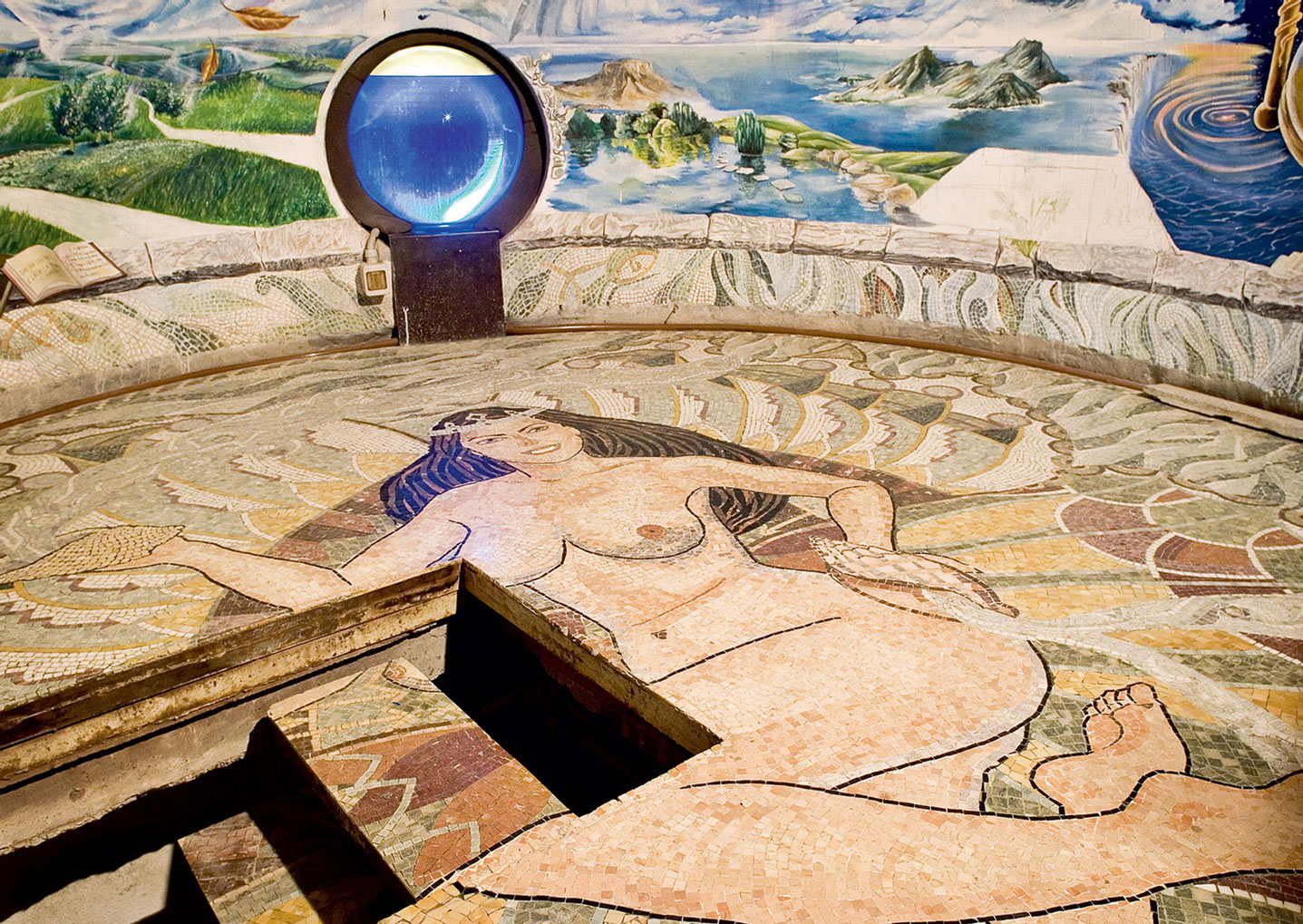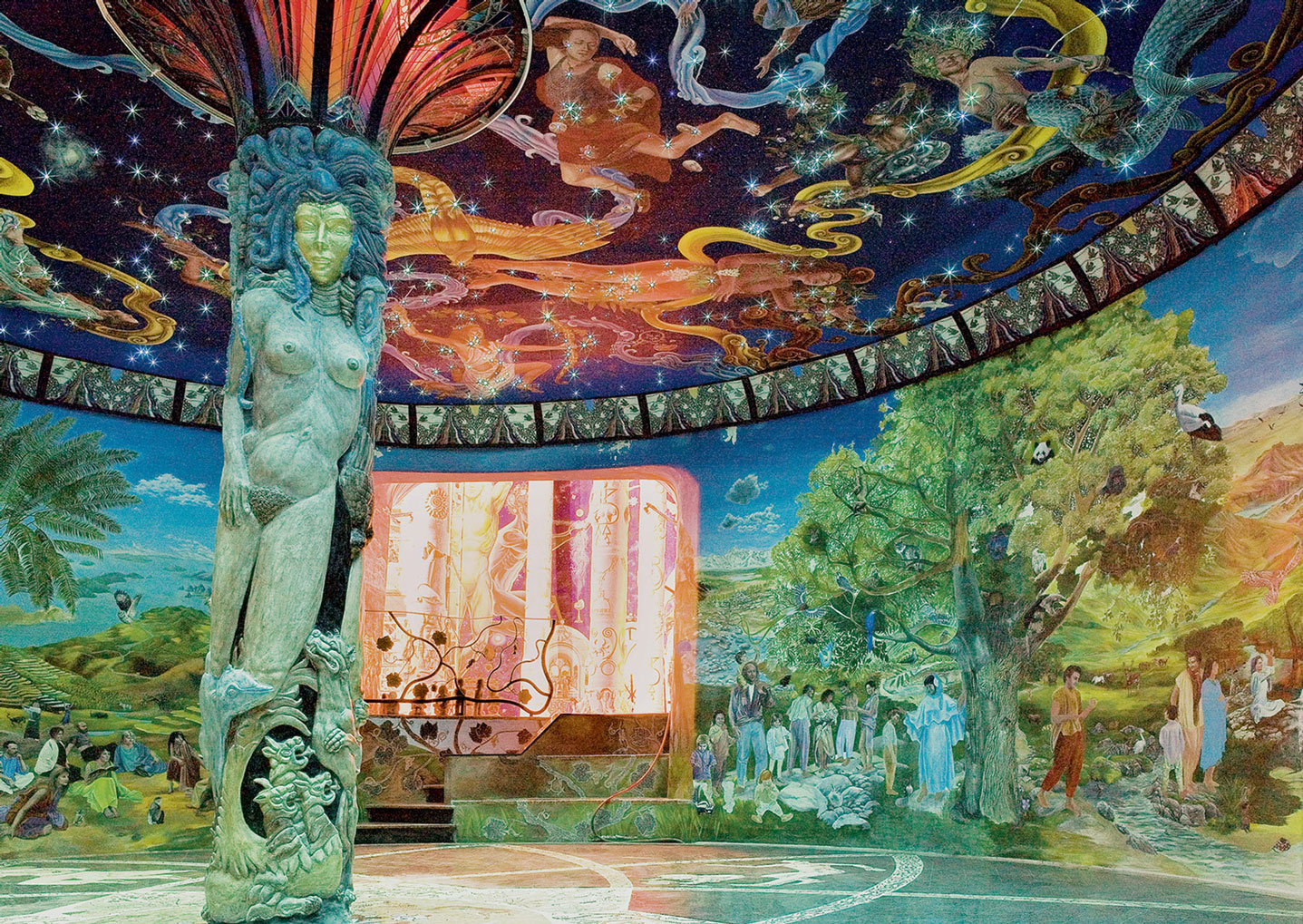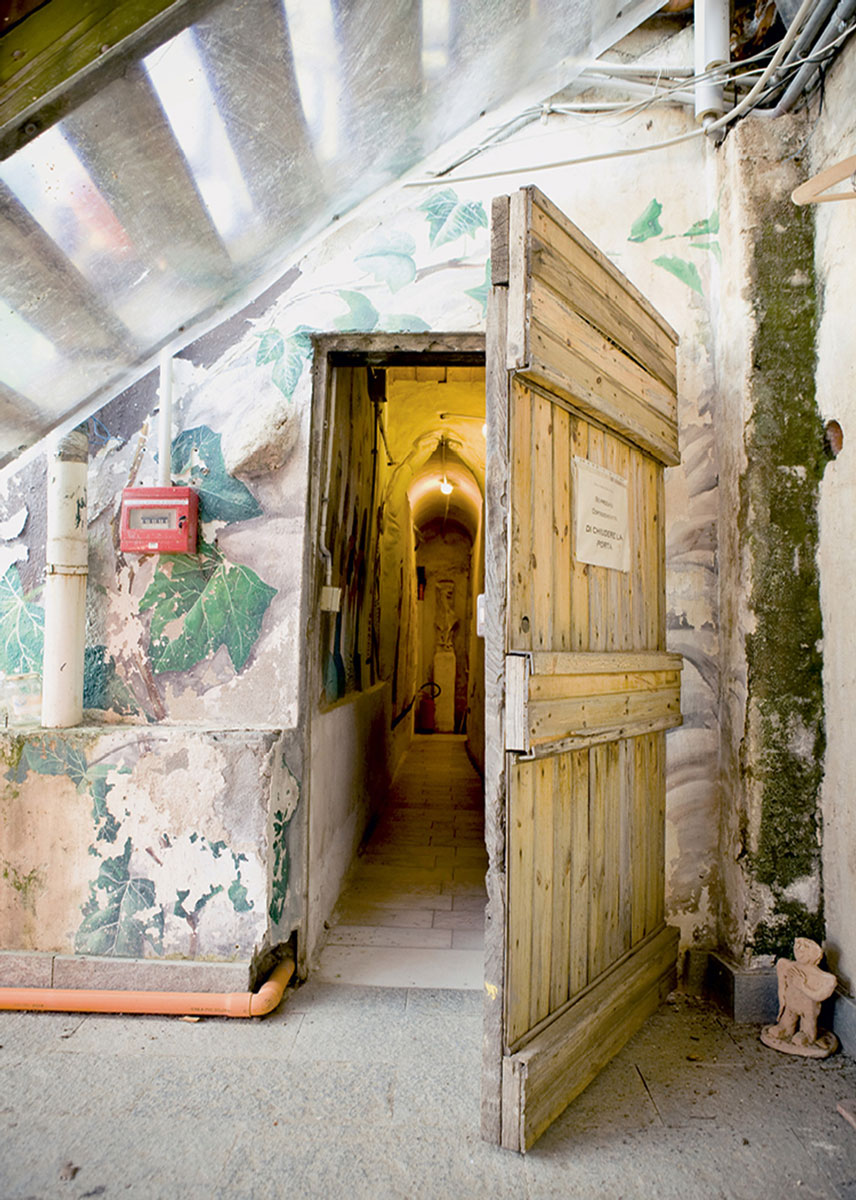Paradise Found
Digging up Damanhur
Magnus Bärtås

Our guide, who calls herself Hare-Violet, asks us to follow her through a narrow gap in the mountain. At the end of this gap is an elevator, much like the one in my apartment building in Stockholm. This is not Stockholm, however, but an area of the Italian Alps that is home to the members of the Damanhur sect, and instead of going down two floors to the familiar street, we descend forty-five meters into the mountain. When the doors open, we step into a round room, approximately ten meters in diameter, which has a shamelessly kitschy pillar sculpted like a tree in the middle. The walls and ceiling are covered with painted scenes; every millimeter has been put to use. Overhead are constellations from the zodiac.
After the initial visual shock, we walk around and take a closer look at the frescoes. They are reminiscent of illustrations from the brochures that Jehovah’s Witnesses hand out. Idealized human beings from diverse backgrounds gather alongside wild animals in idyllic landscapes. After further study, we begin to recognize some of the faces. There is the bearded face of the driver who earlier that day brought us up the mountain; in the painting he ascends a green mountain with his head held high and a searching expression in his eyes. An older woman whom we saw earlier in the day selling information brochures is painted in a long gown, her index finger lifted in a gesture of wisdom. The woman who arranged the linens at our bed-and-breakfast now stands under a tree with foliage that harbors a screaming monkey and colorful birds. A few faces here and there have been brushed out; some others are being worked on and will soon emerge.
This is the first of the many halls, so-called “alchemical laboratories,” and “Egyptian corridors,” that are embedded deep into the mountain and which together constitute the Temple of Humanity—the very heart of the Damanhur sect. We wander through five underground floors replete with gold leaf and marble, mosaic doors, and large domes of Tiffany glass illuminated by artificial sunlight. Here are maple doors that open if you push with your hand on the granite walls—doors that are then transformed into stairs by hydraulic pistons. Here are powders sprinkled with fragrant, fatigue-combating liquids, as well as a room for teleportation. Everything is connected by a tunnel system that supplies fresh air to each chamber.
The Damanhurians have their own founding mythology of the Temple of Humanity. This is recounted in Damanhur: The Community They Tried to Brand a Cult by Jeff Merrifield, who makes no effort to maintain any distance from his subject matter.[1] Instead, he takes on the role of Damanhur’s unofficial historian. According to this founding narrative, Damanhur’s guru and founder, Falco, or Oberto Airaudi as he is legally known, had made a fire on the side of the mountain one warm night in August 1978 together with twelve of his followers. Suddenly, a large star fell from heaven and left a trace of golden dust. Falco took this as a sign, and he announced to his companions that together they had to begin digging immediately into the mountain. They would dig into the heart of the earth and there build a temple the likes of which had not been seen for thousands of years. They would build it by hand, using sheer willpower, and in complete secrecy.
Two of the men began hacking at the mountain immediately. They continued all night, and when they stopped, a new group took over. They worked in shifts, and as more and more people were initiated, they joined in. Their tools during those early days were completely primitive: picks and spades, hammers and chisels. Many more joined, and with time, they moved on to pneumatic drills and other more advanced tools. Soon, they were 150 strong.
For fourteen years, the Damanhurians managed, incredibly, to keep their work secret. To hide the sound of the generators and the drills, they played tapes of chainsaw noises. Certain members were assigned the task of spending entire days sawing timber into tiny pieces so as to give the impression of forestry work. Still, much remains unexplained, not least the question of how they succeeded in disposing of all the earth they dug up and how they managed to lug up all the materials that were needed for the construction of the temple without being found out by the local residents.

But the Damanhurians were nevertheless found out in the end, when, as Merrifield puts it, one of the twelve disciples turned out to be a Judas. In 1991, Filippo Cerutti, who had left the sect, demanded a return of the money he had invested in an apartment in the area. The members decided to comply with his request, but before any funds had been transferred, Cerutti made a new demand: he now wanted twice as much. His request soon turned into blackmail: if the money were not paid, he would reveal the secret of the underground temple. When the Damanhurians refused to pay, Cerutti contacted the Catholic Church about the sect and its activities, though he in fact did not reveal the existence of the subterranean Temple of Humanity. The church in turn decided to dispatch a cardinal from Rome to break up the unholy web of New Age and Satanic sects sprouting all over this region of Piedmont.[2]
In October of that year, the Damanhurians woke up to the sound of helicopters circling over their heads. Their facilities, which included a small village, an outdoor temple, and a school, were stormed by 250 armed policeman with their weapons out. Under the pretense that the operation concerned taxes, the police searched every nook and cranny, from the refrigerators to the children’s shoes. But they found neither the drugs nor the guns they had expected. Even smoking is forbidden by the Damanhurians.
In 1992, the government prosecutor Bruno Tinto arrived at Damanhur. He had procured more complete documentation of the sect’s activities from an unidentified source and demanded to be taken to the underground temple. He threatened to drill the mountain out of existence if the Damanhurians did not cooperate. Realizing he had no other option, Falco acceded and led the prosecutor and four policemen into the mountain. An hour later, they reemerged. The prosecutor led the group, his head bowed down. The local chief of police was sobbing: he’d never seen anything so beautiful in all his life.
Since World War II, this has been a region in great decline. In Vidracco, as the county is called, the number of inhabitants declined in fifty years from fifty thousand to five thousand. The conservative local population in the valley was initially suspicious of the Spiritual People, as they called them (sometimes the People, for short). But since the discovery of the temple, many of them have gradually come to reassess the Damanhurians. After having worked against them, they have now become fully dependent on their activities. After all, Damanhurians have fixed up houses, begun to cultivate lands, and initiated small-scale manufacturing industries. They have their own fire department, officially recognized by the Italian state, and their own section of the Red Cross.
The Damanhurians call their land a federation, which, in addition to the underground temple, now consists of a net of communities in the Valchiusella Valley below Mont Blanc. It is not a large area in size, but occupies a large territory in spirit, it is claimed. Spiritually, the land is ruled by a king and a queen. In the physical world, the Damanhurians have their own constitution in addition to their own newspaper, currency (exchangeable against the Euro), flag, and national anthem. The goal is to provide for all needs on an ecologically sound basis: they have their own hospital, schools, and day-care centers. They have their own wineries and pasta factories.
When joining the federation, members (Falco excepted) take on a name that consists of one word from the animal world and one word from the plant world. They live in large households—nucleos—that are home to twelve to fifteen individuals. Couples announce their desire to get married in front of their nucleo, which then draws up a marriage contract binding the couple to remain together for a certain number of years; this can be set at one, three, or five years. When this designated period comes to an end, the couple can decide whether they want to continue the marriage for a new period; if they do, they are remarried in a new ceremony.
Pregnant women are required to give early notice of their status so that the nucleo can prepare itself practically and economically for the expanded family. Merrifield writes, as if this were the most natural thing in the world, that a DNA sample from every Damanhurian has been collected in an archive. This is done so that genetic testing can be undertaken before any pregnancy is planned in order to see if there are any risks of hereditary diseases. Here Merrifield hints that the Damanhurians, who are mostly engaged in prana healing, have a clandestine “Big Science” resource within the community.
The Damanhurians are a “new people,” if you follow the official proclamations on their website: “At a time in history when the majority of peoples and races are becoming extinct, leaving humanity poorer in culture and diversity, Damanhur has created a human group with its own artistic expression, philosophy and culture.”[3] Alexia Parks, a New Age authority often cited by the Damanhurians, goes even further:
Long ago on earth, the Neanderthal and Cro-Magnon shared the same valley. The Neanderthal died off and Cro-Magnon advanced to become our common ancestor. Today in Italy there is a group of people who call themselves Damanhurians. They may represent the next stage in human development.[4]

In 1995, the underground temple of these representatives of the next stage was classified as Beaux Arts by the Italian state and is therefore permanently protected. The following year, a special law was passed regulating underground buildings, though with only the temple in mind. But is the temple Beaux Arts? Is it not, rather, an enormous folk artwork, albeit one that, it would not surprise me, may one day be known as the eighth wonder of the world?
But the temple is also deeply unsettling, a discomfort that goes hand-in-hand with proclamations of a “new people.” Standing in one of the narrow corridors, I look at some of the small clay figurines that are found everywhere in the temple. They are small and comical, assembled with a few crude moves. But everything is deadly serious in Damanhur. In another hallway, we see a large shelving system that holds clay bricks covered in plastic, each one labeled with the name of a member. Our guide Hare-Violet explains that the archive consists of “tissue samples” from every clay figurine. If a figurine breaks, they will be able to repair it with the same “tissue” from which it was originally made.
Here in the underworld and its strictly controlled archive is the magical representation of every member of the People. In the frescoes on the walls, the face of every citizen is shown in scenes depicting Paradise. One person joins and is added; another person is scrubbed out.
The text is adapted from an essay by Magnus Bärtås and Fredrik Ekman’s “I Damanhur” (“In Damanhur”) published in a collection of essays titled Innanför cirkeln—en resa bland yezidier, damanhurianer och swedenborgare (Stockholm: Bokförlaget DN, 2005).
- Jeff Merrifield, Damanhur: The Community They Tried to Brand a Cult (London: HarperCollins, 1998).
- In addition to Damanhurians and Satanists, the area around Turin is also home to a number of Theosophy groups and Gurdjieff acolytes.
- See Damanhur’s website at damanhur.org/en/.
- Alexia Parks, Rapid Evolution (Eldorado Springs, CO: Education Exchange, 2002), p. 19.
Magnus Bärtås is a writer, artist, and professor of fine arts at Konstfack, Stockholm. The author of two books of essays together with Fredrik Ekman, he has exhibitions and screenings forthcoming at the Power Plant, Toronto; The Museum on the Seam, Jerusalem; and Zendai Moma, Shanghai.
Spotted an error? Email us at corrections at cabinetmagazine dot org.
If you’ve enjoyed the free articles that we offer on our site, please consider subscribing to our nonprofit magazine. You get twelve online issues and unlimited access to all our archives.